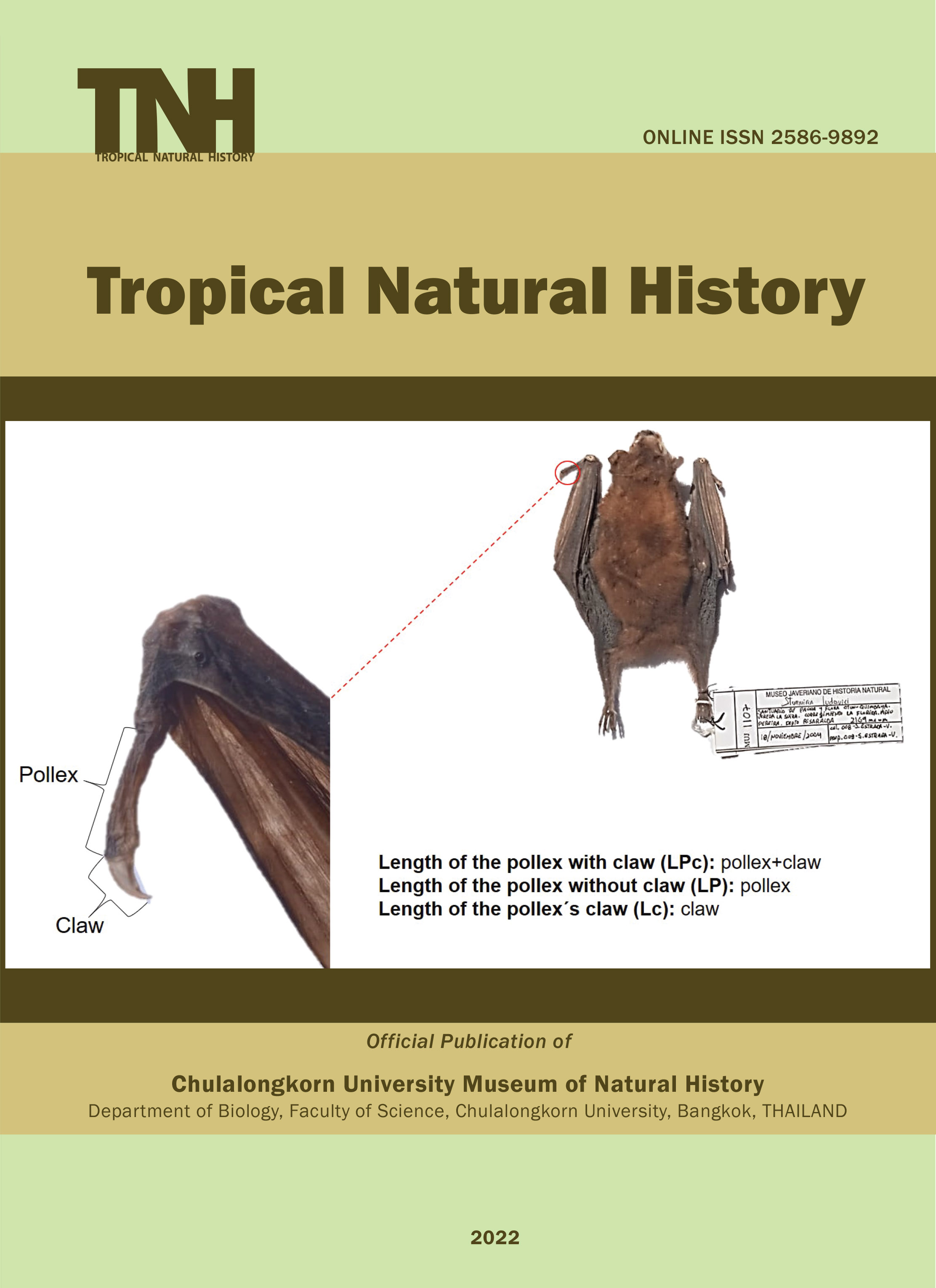Differences in Body Water Turnover Rate Between Naja kaouthia Lesson, 1831 and Malayopython reticulatus (Schneider, 1801) Snakes
DOI:
https://doi.org/10.58837/tnh.22.1.254818Abstract
Total body water and the water turnover were studied in Naja kaouthia Lesson, 1831 and Malayopython reticulatus (Schneider, 1801) snakes by tritiated water dilution techniques. Both snakes species were injected intramuscularly with an aqueous solution carrier-free tritiated water (3H2O) at a single dose of 10 mCi/kg body mass. The equilibration time was determined by taking blood samples for 8 days after the injection. The results show that the absolute values of the rate of water turnover (WTO), water space (TOH) and total body water (TBW) of M. reticulatus were significantly higher than those of N. kaouthia. The relative values of WTO per fat-free, body mass of N. kaouthia were significantly higher than those M. reticulatus, while the biological half-life of tritiated water of N. kaouthia was significantly shorter than those of M. reticulatus. The relative values of both TOH and TBW (% body mass) showed no significant differences between two species. Hematocrit and plasma concentrations of protein, specific gravity, total solid, K+ and Cl- were similar in both snake species, while plasma concentration of Na+ and plasma osmolality were significantly higher in N. kaouthia than M. reticulatus. These results suggest that a lower WTO as a percentage of body mass and a higher biological half-life of 3H2O of M. reticulatus in comparison with N. kaouthia could be attributed to relatively higher efficiency in the water retention mechanism, which M. reticulatus could be a well adaptation to the tropical environment.
References
Chaiyabutr, N., Komolvanich, S., Sawangkoon, S., Preuksagorn, S. and Chanpongsang, S. 1997. The regulation of body fluids and mammary circulation during late pregnancy and early lactation of crossbred Holstein cattle feeding on different types of roughage. Journal of Animal Physiology and Animal Nutrition. 77: 167–179.
Holleman, D. F., White, R. G. and Luikj, R. 1982. In: Use of Tritiated Water in Studies of Production and Adaptation in Ruminants. IAEA, Vienna: 9-32.
Macfarlane, W.V. and Howard, B. 1970. In Physiology of Digestion and Metabolism in the Ruminant, Ed. A. T. Phillipson, Oriel Press, Newcastle upon Tyne: p 362.
Macfarlane, W.V. and Howard, B. 1972. Comparative water and energy economy of wild and domestic mammals. Symposium Zoological Society. 31: 261–296.
Secor S. M. and Diamond J. 1998. A vertebrate model of extreme physiological regulation. Nature. 395: 659-662.
Seebacher, F. and Franklin, C. E. 2005. Physiological mechanisms of thermoregulation in reptiles: a review. Journal of Comparative Physiology B. 175: 533–541.
Shipley, R.A. and Clark, R. E. 1972. Tracer Methods for in vivo Kinetics. New York: Academic Press.
Silveira, P.F., Koike, T.I., Schiripa, L.N., Reichl, A.P., Magnoli, F.C.and Mimura, O.M. 1998. Plasma arginine-vasotocin and hydroosmotic status of the terrestrial pit viper Bothrops jararaca. General Comparative Endocrinology. 109: 336–346
Sitprija, S., Kwanthongdee, J., Vasaruchapong, T., Chanhome, L. and Chaiyabutr, N. 2016. Distribution of Body Fluid in Reticulated Python, Broghammerus reticulatus (Schneider, 1801), During Subcutaneous Administration with Ringer's Acetate Solution. Tropical Natural History. 16 (1): 33-42.
Smits, A.W. and Lillywhite, H.B. 1985. Maintenance of blood volume in snakes: transcapillary shifts of extravascular fluids during acute hemorrhage. Journal of Comparative Physiology B. 155: 305–310.
Stevenson, R.D., Peterson, C.R. and Tsui, J.S. 1985. The thermal dependence of locomotion, tongue flicking, digestion, and oxygen consumption in the wandering garter snake. Physiological Zoology. 58: 46-57.
Terrien, J., Perret, M., and Aujard, F. 2011. Behavioral thermoregulation in mammals: a review. Front Bioscience (Landmark Ed). 16: 1428-44.
Vaughan, B. E. and Boling, E. A. 1961. Rapid assay procedures for tritium labelled water in body fluid. Journal of Laboratory Clinical Medicine. 57: 159–164.
Downloads
Published
How to Cite
Issue
Section
License
Chulalongkorn University. All rights reserved. No part of this publication may be reproduced, translated, stored in a retrieval system, or transmitted in any form or by any means, electronic, mechanical, photocopying, recording or otherwise, without prior written permission of the publisher












